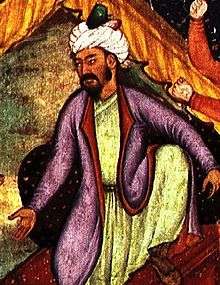Barlas
| Barlas برلاس | |
|---|---|
| Parent house | Borjigin |
| Titles | Khan, Mirza, Baig, Shah, Sardar, Emir, Ghazi, Sultan |
| Founder | Qarchar Barlas |
The Barlas (Mongolian: Barulas;[1] Chagatay/Persian: برلاس Barlās; also Berlas) were a Mongol[1] and later Turkicized[2][3] nomadic confederation in Central Asia.[4][5]
Origins

According to the Secret History of the Mongols, written during the reign of Ögedei Khan [r. 1229-1241], the Barlas shared ancestry with the Borjigin, the imperial clan of Genghis Khan and his successors, and other Mongol clans. The leading clan of the Barlas traced its origin to Qarchar Barlas,[2] head of one of Chagatai's regiments. Qarchar Barlas was a descendant of the legendary Mongol warlord Bodonchir (Bodon Achir; Bodon'ar Mungqaq), who was also considered a direct ancestor of Genghis Khan.[6]
Due to extensive contacts with the native population of Central Asia, the tribe had adopted the religion of Islam,[3] and the Chagatai language, a Turkic language of the Qarluq branch, which was heavily influenced by Arabic and Persian.[7]
Timurids and Mughals
.png)
Its most famous representatives were the Timurids, a dynasty founded by the conqueror Timur (Tamerlane) in the 14th century, who ruled over modern-day Iran, Armenia, Azerbaijan, Georgia, and almost the entire rest of the Caucasus, Afghanistan, much of Central Asia, as well as parts of contemporary Pakistan, India, Mesopotamia, and Anatolia.[8] One of his descendants, Zahir ud-Din Babur, later founded the Mughal Empire of Central Asia and South Asia.
See also
References
- 1 2 Grupper, S. M. ‘A Barulas Family Narrative in the Yuan Shih: Some Neglected Prosopographical and Institutional Sources on Timurid Origins.’ Archivum Eurasiae Medii Aevi 8 (1992–94): 11–97
- 1 2 B.F. Manz, The rise and rule of Tamerlan, Cambridge University Press, Cambridge 1989, p. 28: "... We know definitely that the leading clan of the Barlas tribe traced its origin to Qarchar Barlas, head of one of Chaghadai's regiments ... These then were the most prominent members of the Ulus Chaghadai: the old Mongolian tribes — Barlas, Arlat, Soldus and Jalayir ..."
- 1 2 M.S. Asimov & C. E. Bosworth, History of Civilizations of Central Asia, UNESCO Regional Office, 1998, ISBN 92-3-103467-7, p. 320: "… One of his followers was […] Timur of the Barlas tribe. This Mongol tribe had settled […] in the valley of Kashka Darya, intermingling with the Turkish population, adopting their religion (Islam) and gradually giving up its own nomadic ways, like a number of other Mongol tribes in Transoxania …"
- ↑ Encyclopædia Britannica, "Timur", Online Academic Edition, 2007. Quotation: "Timur was a member of the Barlas tribe, a Mongol subgroup that had settled in Transoxania (now roughly corresponding to Uzbekistan) after taking part in Genghis Khan's son Chagatai's campaigns in that region. Timur thus grew up in what was known as the Chagatai khanate." ...
- ↑ G.R. Garthwaite, "The Persians", Malden, ISBN 978-1-55786-860-2, MA: Blackwell Pub., 2007. (p.148)
- ↑ The Secret History of the Mongols, transl. by I. De Rachewiltz, Chapter I Archived February 23, 2007, at the Wayback Machine..
- ↑ G. Doerfer, "Chaghatay Archived November 18, 2007, at the Wayback Machine.", in Encyclopædia Iranica, Online Edition 2007.
- ↑ René Grousset, The Empire of the Steppes: A History of Central Asia, Rutgers University Press, 1988. ISBN 0-8135-0627-1 (p.409)